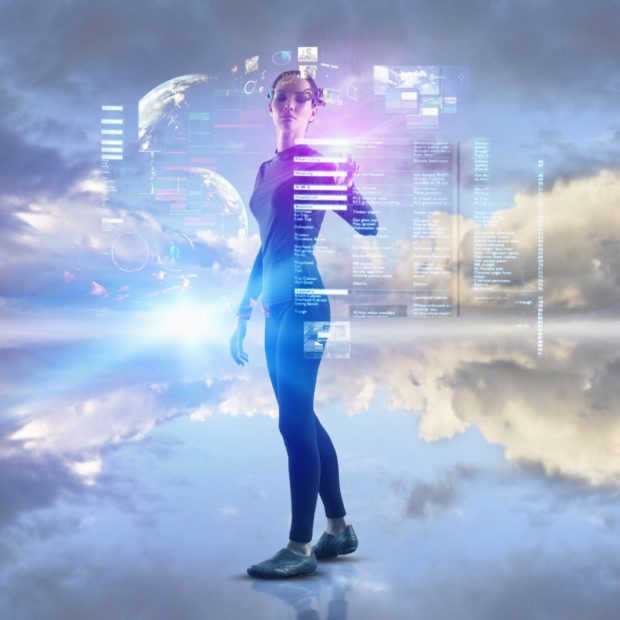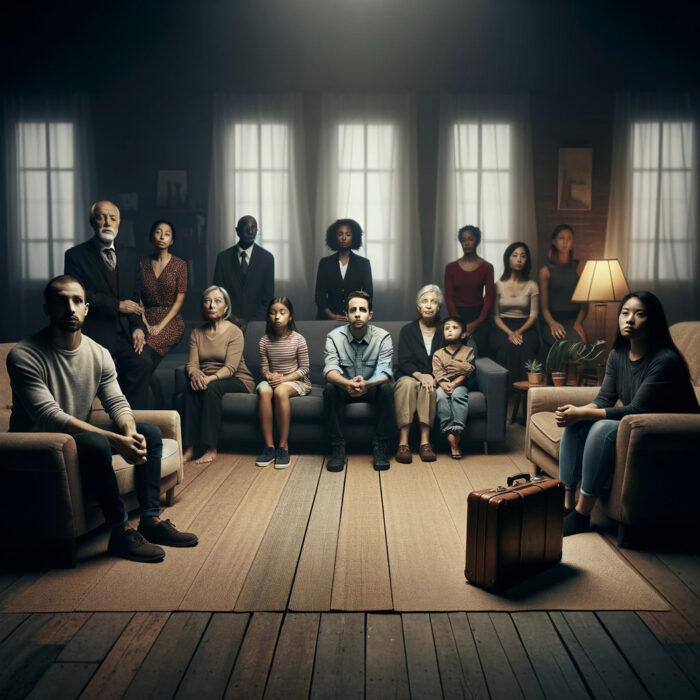You have no items in your cart. Want to get some nice things?
Go shoppingCory Doctorow’s Down and Out in the Magic Kingdom is set in a near-future where everyone is effectively immortal, and money has been replaced by the crudest form of social capital – power is determined by popularity rankings called “whuffies.” The book’s protagonist, Jules, and his girlfriend, Lili, live an idyllic life in Disneyland, maintaining and repairing the old rides. However, new engineers are in town, peddling augmented reality sim rides that adapt to consumer preferences in real time.
“Why didn’t you tell me?” she said, after a hard moment’s staring into the moonlight reflecting off the river.
“Tell you?” I said, dumbly.
“They’re really good. They’re better than good. They’re better than us. Oh, God.”
[…] “I don’t think so. I don’t think they’ve got soul, I don’t think they’ve got history, I don’t think they’ve got any kind of connection to the past. The world grew up in the Disneys — they visit this place for continuity as much as for entertainment. We provide that.” I’m offline, and they’re not — what the hell happened?
“It’ll be okay, Lil. There’s nothing in that place that’s better than us. Different and new, but not better. You know that — you’ve spent more time in the Mansion than anyone, you know how much refinement, how much work there is in there. How can something they whipped up in a couple weeks possibly be better that this thing we’ve been maintaining for all these years?”
She ground the back of her sleeve against her eyes and smiled. “Sorry,” she said. Her nose was red, her eyes puffy, her freckles livid over the flush of her cheeks. “Sorry — it’s just shocking. Maybe you’re right. And even if you’re not — hey, that’s the whole point of a meritocracy, right? The best stuff survives, everything else gets supplanted.”
In this exchange, a contradiction immediately emerges – the augmented reality is both self-evidently better than the real thing, and self-evidently worse than it. If it wasn’t better, why would Lili be so threatened? If it wasn’t worse, why would there be reason to mourn? Jules insists that the original staying power of the Disney rides is due to ineffable qualities, such as history and soul. The augmented reality is, yes, potentially more entertaining, more immerse, but it is not real.
Disneyland is perhaps an odd venue to use as a stage to fight about the real. After all, postmodern theorist Jean Baudrillard refers to Disneyland as a space designed to confront hyperreality. As he wrote in his 1981 book, Simulacra and Simulation, “Disneyland is presented as imaginary in order to make us believe that the rest is real, when in fact all of Los Angeles and the America surrounding it are no longer real, but of the order of the hyperreal and of simulation. It is no longer a question of a false representation of reality (ideology), but of concealing the fact that the real is no longer real, and thus of saving the reality principle.” Baudrillard argues that in contemporary society, our reality is filtered through new media (primarily, but not exclusively, television) and our urban lives are designed to cut us off from nature. Therefore, there is a very real sense that our reality is no longer “real” – that we are surrounded by representations that don’t have a real counterpart. This is the simulacra of the title. Disneyland exists to be an incredibly visible copy of America – to reassure us that, by contrast, everything outside is real.
And yet the characters of Down and Out in the Magic Kingdom cling to the reality of the physical rides over the augmented reality. Part of this is because one symptom of the postmodern condition is the belief that we have run out of anything meaningful to say through art – as Frederic Jameson argued, the best we can hope for is new and novel forms of pastiche. We cling to the past forms of art as inherently better and more authentic.
Augmented reality is at the cutting edge of entertainment technology – most peoples’ first experience with it will have been 2016’s mobile game Pokémon Go. (Again, even the new technology is packaged with a nostalgic intellectual property – Pokémon Go promises to make the childhood fantasy of Pokémon real, combining the old and the new.) Although the concept of AR has been around for a while – hence Doctorow’s usage of it in his novel – it has become more commonly included in science fiction literature, film and television since 2016. Part of the reason is surely novelty – these works portray the use of AR, now novel, as commonplace, reinforcing the futurity of their settings. But AR functions as more than a curiosity.
Augmented reality’s ghostliness is emblematic of the cheapness and ephemerality of modern capitalism. We live in a rentier economy – fewer and fewer people own their own homes, for example. Video streaming services curtail our choices (try finding a film on Netflix made before 1970) while ensuring that we never own films or music. Even tracks bought on iTunes are not really ours – they are subject to recall at any time. Augmented reality in these works is a frustrating reminder of this reality. It is a form of entertainment that you pay for, but can never touch – and never truly possess.
Denis Villeneuve’s 2017 film Blade Runner 2049 gets at the pitifulness of augmented reality. A sequel to the 1982 cult classic Blade Runner, the film follows K, a replicant (an enslaved artificial human) who works for the LAPD to track down and kill rogue replicants. K’s personhood is evident, even though he is owned by the state, as evidenced by his longing for companionship.
After work, K comes home to a tiny apartment in the sprawling megacity. He is greeted by his holographic girlfriend, Joi. Joi is programmed to adore her owner, and she is quite literally confined to the home. Joi can be a hard character for a feminist to love. Although the use of holograms in science fiction is not new, there are several moments where Joi recalls contemporary AR – the moment when she superimposes her image over the replicant sex worker Mariette, their movements not quite syncing up, recalls not only contemporary deepfakes controversies, but also plays off the same eerie disconnect between the incorporeal image and the real world that makes, say, seeing a Pikachu in a graveyard so fascinating. The incongruity calls attention to the lack of embodiment.
In many ways, Joi is a retrograde sexual fantasy – a virtual woman utterly devoted to her man, willing to do anything to please him. The old-fashioned gender politics seems to be baked into Blade Runner’s DNA. The original film featured Rachael, who was styled like a 1940s femme fatale. Unlike the duplicitous yet in-control women of film noir, Rachael passively fell in love with Deckard after he forces himself on her. Blade Runner’s use of film noir elements is emblematic of our inability to imagine a different future – this is perhaps even more apparent in the countless cyberpunk novels and films since then that have shamelessly plagiarised Blade Runner’s “Art Deco for the rich, dirty Asian-ish back alleys for the poor” visual aesthetic. The films also reassert the primacy of the male – if Rachael was a 40s new woman defanged as part of the 1980s backlash against feminism, Joi is a 1950s housewife for a generation that can afford neither a house or a wife.
On the other hand, it may be that Joi is not so simple to read. After all, Rachael was meant to be a “real” woman – she was unaware of her status as a replicant before Deckard figured it out, and her memories are that of Tyrell’s real niece. She is meant to be fully in control of her actions, and yet she is utterly subservient to Deckard. There is little indication in the film that her declaration of love at the end is false – despite her insistence that she didn’t want to sleep with him. Joi, on the other hand, is explicitly a fantasy, bought for one specific purpose – to provide companionship for a being that is deemed unfit for human company. Even then, Joi manages to break from her programming. When K leaves the city to track down Deckard, Joi insists on coming with, even if it means that her automatic backup will no longer work. She is murdered on the trip – lost forever.
One recurring image in Blade Runner 2049 is the extensive use of large-scale holographic advertisements. In one sequence, K walks between the giant feet of a ballerina, projected to be storeys high. After his copy of Joi dies, K encounters a giant advertisement for a new Joi. Although this one is also played by Ana de Armas, her look is entirely different – she is naked, with neon-blue hair. Her features are smoothed out, and her exaggerated size emphasises her unreality. She flirts with K, but he walks away disillusioned. The Joi he knew was different, and she will never come back. We are one of the loneliest generations, and K finds to his despair that love – real love – cannot be bought.
The theorist Mark Fisher argues that contemporary art, and contemporary society, is locked into “capitalist realism.” While the 2008 financial crash has exposed the failings of the capitalist system, we are no longer able to imagine any alternatives to it. However, 2016 had the effect of rupturing, at least partially, the logic of capitalist realism. The Bernie Sanders movement and the current UK Labour party have rejected the dominance of capitalism, while followers of Donald Trump have rejected the logic of realism. Blade Runner 2049 shows some of the cracks in the ideology of never-ending capitalist stasis. Film academic Robin Woods wrote that Blade Runner should have ended with Deckard joining a replicant liberation movement – Blade Runner 2049 shows us that movement gaining ground. Augmented reality also plays a large part in two 2017 video games that criticise privatised capitalism – Prey and Tacoma.
Both games are set in a world where privatised space travel has become commonplace – in many ways fulfilling the dreams of Elon Musk and Richard Branson. Prey is set in an alternate history where John F. Kennedy lived and rapidly advanced the space programme, while Tacoma is more clearly extrapolating from our current world, as companies such as Amazon, Hilton and Carnival (a cruise company) are explicitly name-dropped. Both programs feature a protagonist exploring a largely-abandoned space station. In Prey, Morgan Yu is exploring the Talos station after the release of deadly aliens; in Tacoma, Amy is investigating a lunar space station on behalf of the fictional Venturis Corporation following a purported accident.
In both games, augmented reality is not a recreational tool, but is key to corporate tracking and surveillance, and is used to help understand what happened on these space stations. The use of AR is fairly incidental in Prey – Morgan uses the recorded footage of the lead-up to the aliens escaping in order to figure out why they lost their memories, and determine the true motivations of their brother, Alex. The use of AR is utilitarian, although the effect of Morgan walking around the projection and seeing the same event from different angles is fascinating.
While AR is merely used as a narrative shorthand in Prey, AR is central to the narrative and themes of Tacoma. The AR is used to track the movements of the workers at all times – speaking to an extreme version of current corporate surveillance culture. The crew of the Tacoma are absent from the ship, but their recorded movements and conversations are represented by brightly-coloured silhouettes. Much like the previous game made by Fulbright Studios, the highly influential indie hit Gone Home, Tacoma allows you to dig through other peoples’ lives in order to solve a mystery. Like Gone Home, the pleasure of eavesdropping is in uncovering the full humanity of the absent people you are observing. While Amy is hired to assess the corporation’s liability in the accident, that is not what is most striking about the narrative. While the AR is also intangible and ethereal, it is also remarkably intimate. The player can watch a crew member rehearse his declaration of love for another – an endearing moment of privacy. While it is immensely rewarding to discover these moments, it calls to mind the pervasive access that their employer has to their every movement.
Like Blade Runner 2049, Tacoma both takes place in a dystopian extension of current capitalist logic, but also offers a way out. (Without spoiling anything, Prey is much more pessimistic.) Tacoma’s recordings take place on Obsolescence Day, which is an annual holiday for the blue-collar workers. It is later revealed that Obsolescence Day commemorates the day that human workers were meant to be replaced by artificial intelligence. This was blocked by a strong trade union movement. It is then later revealed that the Venturis Corporation engineered the accident in order to have an excuse to remove human workers from their spaceships. The ruthlessness of the corporate system seems to resonate with, say, the despicable conditions in Amazon warehouses, and the human crew members are often stuck in impossible positions – while none of them are particularly happy with the Venturis corporation, they are also unable to leave steady work. The crew are in the end rescued by a rival company – suggesting that, while Venturis may be harmed by these revelations, the capitalist system will continue unimpeded.
However, the existence of trade unions in highly precarious industries seemed like a fantasy in 2017. Silicon Valley, and start-up culture in general, is notoriously hostile to organised labour. But Google contractors recently became the first significant union in the tech sector. Tacoma suggests a future of human solidarity (and AI solidarity) in the face of corporate malfeasance. Banding together can work. In the end, the humans survive because a rebellious ship AI (ODIN) rebels against its programming and tips off the crew as to the corporation’s plans. ODIN is then due to be destroyed for disobeying orders. In one final twist, Amy is revealed to be a secret agent for an AI liberation movement, and she offers ODIN asylum. Like the replicants of Blade Runner¸ ODIN is an intelligent creation that is owned by an organisation that does not have its best interests at heart. Tacoma suggests that there may be a way out of this bind, but it requires class solidarity and radical action.
Augmented reality, then, holds a strange place in contemporary science fiction. It reflects some of the direst failings of our current system – our inability to own anything, our loneliness, our reliance on employers who seek to exploit us. But in these works of fiction, we can see a way out of this conundrum. It won’t be easy, and the gains may be partial – but it is better than surrendering to despair. Science fiction reflects our world, extrapolating our hopes and fears in a distant setting. But science fiction also provides a vision of the future. These works suggest that what we want this future to be is entirely in our hands.

Olivia Belton
Olivia Belton is a research associate on the AI: Narratives and Justice project. She recently completed a PhD in Film, Television and Media Studies at the University of East Anglia, and previously studied English Literature at the University of Sheffield. Her research interests include science fiction, feminist media studies and emergent technology. Her previous work has considered the depiction of genetic engineering, robotics and artificial intelligence in popular science fiction television. At CFI, she is exploring public perceptions and media representation of autonomous flight.





